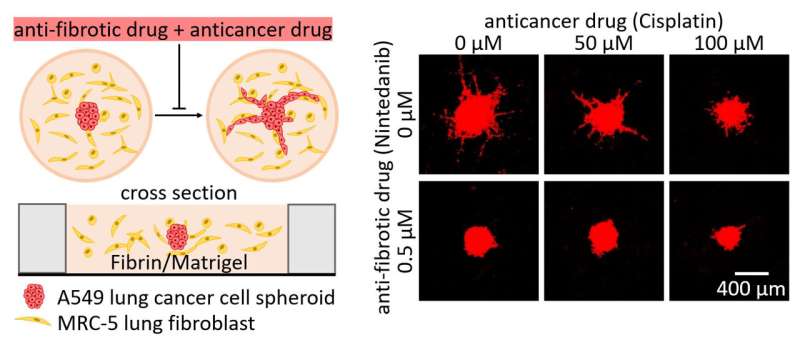A 3D co-culture system mimics the tumor microenvironment for studying the impact of drug combinations. An anti-fibrotic drug, nintedanib, could improve the effect of an anti-cancer drug, cisplatin, to reduce tumor growth and invasion. Credit: Huei-Jyuan Pan
Fibroblasts build and maintain the extracellular matrix, or physical scaffolding for cells, in the connective tissues within the body. It is believed that cancerous tumors can recruit nearby fibroblasts and use them to promote their own growth and invasion. This process, called cancer-associated fibroblast activation, can also protect tumors from chemotherapy and make treatment difficult.
Researchers from Academia Sinica, National Yang Ming Chiao Tung University, National Taiwan University Hospital, and National Taiwan University have developed a 3D cell culture system to test how inhibiting fibroblast activities can help treat lung cancer. They found that combining the anti-fibrotic drug nintedanib with the anti-cancer drug cisplatin increased the efficacy of the latter. The research is published in APL Bioengineering.
"Nearly 90% of late-stage lung cancer patient deaths are caused by the spread of tumors to other organs, rather than the primary tumor," said author Chau-Hwang Lee. "Therefore, it is crucial to find ways to inhibit lung cancer metastasis to prolong the lives of lung cancer patients."
To simulate the tumor microenvironment and mimic real tissues, the team co-cultured lung cancer cells and fibroblasts in a 3D matrix. The cancer cells formed a spheroid, around which the fibroblasts were randomly distributed.
The researchers tested the anti-cancer drug cisplatin with and without two anti-fibrotic drugs, nintedanib and pirfenidone. They measured indicators of tumor growth and invasiveness, finding that nintedanib improved the anti-cancer efficacy of cisplatin. Pirfenidone did not show a similar effect.
"Our results suggest that the combination of nintedanib and cisplatin could be an effective treatment strategy for lung cancer by targeting both cancer cells and cancer-associated fibroblast activation surrounding the tumor," said Lee.
The 3D cell culture system will be a valuable tool for assessing the efficacy of other drug combinations on tumor growth and invasion. It could eliminate the need for animal testing while still reliably evaluating drug efficacy and safety.
"This study could pave the way for the development of more effective treatment strategies for lung cancer and other solid tumors," said Lee. "It is our hope that this study will introduce a new, promising tool for preclinical drug testing."
The authors plan to study other types of cancers, such as liver and oral cancer, using the same system. They also hope to improve the culture to better mimic the tumor microenvironment.
The article, "A 3D culture system for evaluating the combined effects of cisplatin and anti-fibrotic drugs on the growth and invasion of lung cancer cells co-cultured with fibroblasts," is authored by Huei-Jyuan Pan, Chia-Wei Lee, Li-Yu Wu, Heng-Hua Hsu, Yi-Chung Tung, Wei-Yu Liao, and Chau-Hwang Lee. It will be published in APL Bioengineering on March 28, 2023.
More information: A 3D culture system for evaluating the combined effects of cisplatin and anti-fibrotic drugs on the growth and invasion of lung cancer cells co-cultured with fibroblasts, APL Bioengineering (2023). DOI: 10.1063/5.0115464
Provided by American Institute of Physics
























